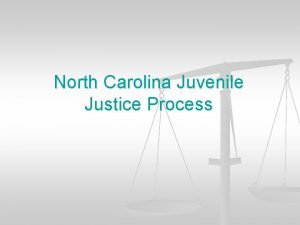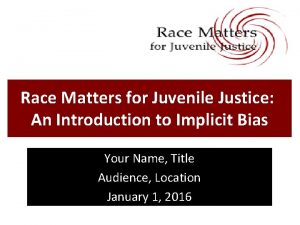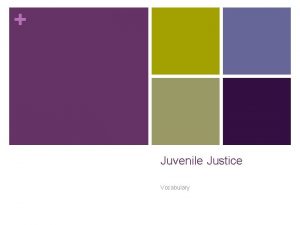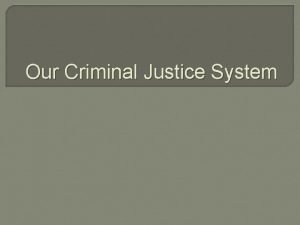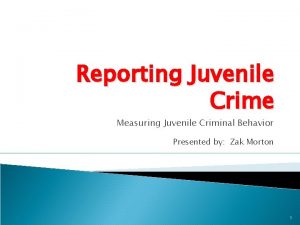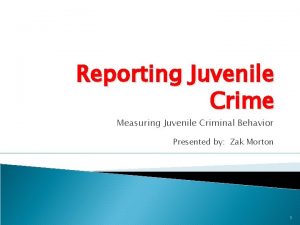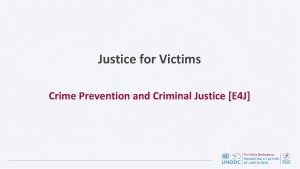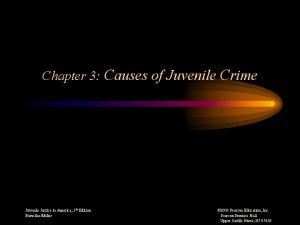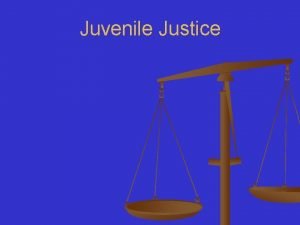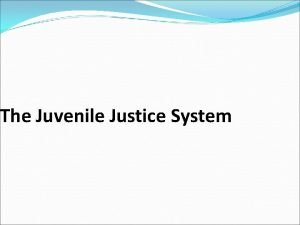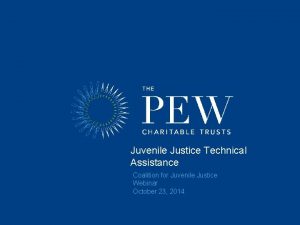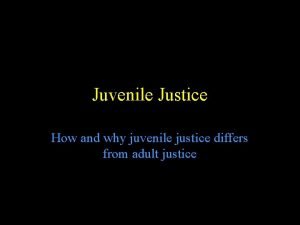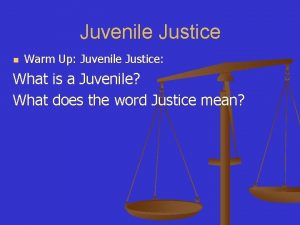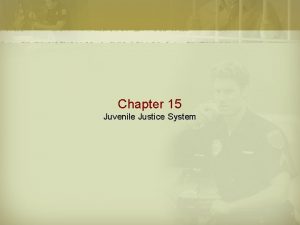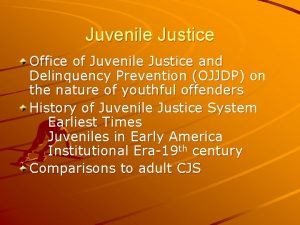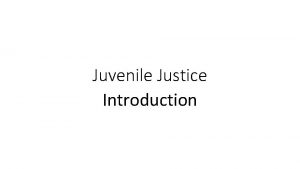Oregon Criminal Justice Commission Juvenile Crime Prevention Evaluation




























- Slides: 28

Oregon Criminal Justice Commission Juvenile Crime Prevention Evaluation Phase 2 Interim Report Findings in Brief April 2003 JCP Evaluation Interim Report

Enabling legislation: SB 555 (1999) • The purpose of JCP is to prevent and reduce juvenile crime • JCP programs utilize research and evidence-based practices • These practices target youth with 2 or more of the following factors that put them at risk for juvenile crime: 1. Antisocial behavior 2. Poor family functioning or support 3. Failure in school 4. Substance abuse problems 5. Negative peer association JCP Evaluation Interim Report

The JCP approach aims to reduce juvenile crime and associated risk factors: It is working to reduce risk and increase protective factors for targeted youth JCP Evaluation Interim Report

JCP provides research-based prevention services to youth at high risk for delinquency, and their families • Youth must have multiple risk factors for juvenile delinquency • Communities fund services based on local needs, within guidelines set by JCPAC • Services include direct interventions, case management, and resources to help families meet basic needs JCP Evaluation Interim Report

Research basis of JCP • Over 40 years of research document effective strategies to prevent and reduce juvenile crime § § § U. S. Department of Justice; U. S. Surgeon General (2001) University of Maryland (Gottfredson) Washington State Institute for Public Policy Loeber & Farrington; Hawkins & Catalano; Latessa Oregon Social Learning Center (Reid, Patterson, Walker) IVDB (Walker et al. ) § Research converges on same findings: interventions targeting risk factors for juvenile delinquency reduce juvenile crime JCP Evaluation Interim Report

Juvenile Crime Prevention: Oregon’s model • Basic Services and High-Risk Prevention Services • All 36 counties participating; working with 9 tribes in development of tribal JCP plans • Different interventions based on local needs, but all are research based and target the five areas that put youth at risk for involvement in juvenile crime JCP Evaluation Interim Report

High Risk Youth Identified JCP Interventions Basic and Diversion Services Intermediate Outcomes: Risks Decreased; Protective Factors Increased High Level Outcomes 1. Reduce Juvenile Arrests 2. Reduce Juvenile Recidivism 3. Stay within OYA bed limit JCP Evaluation Interim Report

JCP interventions target risk factors for juvenile crime Examples from local plans: • Clackamas County: parent training, substance abuse treatment • Jackson County: tutoring, intensive parenting program • Malheur County: multi-dimensional services • Multnomah County: early intervention for youth 11 years and younger with a law violation, residential drug and alcohol treatment • Yamhill County: family functional therapy, truancy program JCP Evaluation Interim Report

JCP programs are reaching the right youth • JCP provides interventions for youth at high risk of delinquency • Almost 5, 000 youth were enrolled in JCP high-risk prevention services in the first year of this biennium (7/1/01 – 6/30/02) • Participating juveniles have issues in an average of 3 of the 5 risk areas JCP Evaluation Interim Report

Who is being served? • Males: 66% ; Females: 34% • Average 14 years (range 7 -18) • White: 70%; Latino: 11. 4%; Black: 4. 3%; Native American: 3%; Asian: 1. 1%; Multi: 1. 9%; Other/Unknown: 8. 3% JCP Evaluation Interim Report

Who is being served? • Youth have multiple risk domains that need to be targeted • Many youth have multiple indicators within each risk domain • 27. 8% of youth were rated as having a serious mental health issue JCP Evaluation Interim Report

Juveniles have issues in multiple domains that put them at risk of delinquency § Antisocial behavior § Poor family functioning or support § Failure in school § Substance abuse problems § Negative peer association JCP Evaluation Interim Report

High Risk Youth Identified JCP Interventions Basic and Diversion Services Intermediate Outcomes: Risks Decreased; Protective Factors Increased High Level Outcomes 1. Reduce Juvenile Arrests 2. Reduce Juvenile Recidivism 3. Stay within OYA bed limit JCP Evaluation Interim Report

Results • JCP youth had reduced risk for delinquency • Reductions were seen in all 16 risk indicators JCP Evaluation Interim Report

JCP reduces risk for delinquency • By youth: üYouth had an average of 43% fewer risk indicators after JCP services • By risk indicators: üReductions ranged from 15% to 88% üParticularly large reductions were seen in the anti-social behavior area (72% to 86%) JCP Evaluation Interim Report

JCP reduces risk for delinquency RISK DOMAIN % of risk indicators that were eliminated, Time 1 to Time 2 School Failure 60% Negative Peers 42% Antisocial Behavior Poor Family Functioning Substance Abuse 78% 47% 43% JCP Evaluation Interim Report

Examples of reductions in risk indicators SCHOOL FAILURE Academic Failure: Failing 2 % of juveniles whose risk indicator was eliminated from Time 1 to Time 2 58% of juveniles or more classes Chronic Truancy: Skips 59% of juveniles school at least once a week or more than 4 times past month School Dropout: Stopped 58% of juveniles attending school or not enrolled JCP Evaluation Interim Report

Changes in Risk Factors JCP Evaluation Interim Report

JCP protects against delinquency • Youth who participated in JCP programs had increases in protective indicators • All 10 protective indicators increased over time • Improvements ranged from 32% to 79% JCP Evaluation Interim Report

JCP increases protective indicators % of juveniles PROTECTIVE INDICATORS who gained this indicator during JCP Family actively involved in helping 42% of juveniles youth succeed in school Has friends who are academic achievers 57% of juveniles Communicates effectively with 54% of juveniles family members JCP Evaluation Interim Report

High Risk Youth Identified JCP Interventions Basic and Diversion Services Intermediate Outcomes: Risks Decreased; Protective Factors Increased High Level Outcomes 1. Reduce Juvenile Arrests 2. Reduce Juvenile Recidivism 3. Stay within OYA bed limit JCP Evaluation Interim Report

JCP High-Level Outcomes • Reduce Juvenile Arrests • Reduce Juvenile Recidivism • Stay within Oregon Youth Authority Bed Limit JCP Evaluation Interim Report

Juvenile Criminal Referral Rate by Year JCP Evaluation Interim Report

Percent of high risk nonoffenders with a subsequent first referral within 12 months JCP Evaluation Interim Report

Reduce Juvenile Recidivism • Recidivism for JCP participants is lower than other juvenile offenders • The offenses of JCP program youth were less serious and less frequent than before their JCP intervention. • There has been a reduction in the recidivism rate of first time offenders. JCP Evaluation Interim Report

Pre-Post Comparison of Criminal Offending Percent of juvenile department referrals with criminal referral 12 months before and 12 months after enrollment in JCP Prevention services JCP Evaluation Interim Report

Re-offending by Youth with Prior Criminal Referrals: JCP Youth, Compared to Youth Offenders Statewide JCP Evaluation Interim Report

Demonstrated Benefits of JCP • Reductions in youth problem behaviors and other risk factors that put youth at higher risk of juvenile justice involvement • Increases in protective factors that prevent youth from juvenile justice involvement • Increased public safety due to reductions in juvenile recidivism JCP Evaluation Interim Report
 Unit 2 criminal law and juvenile justice
Unit 2 criminal law and juvenile justice Primary prevention secondary prevention tertiary prevention
Primary prevention secondary prevention tertiary prevention North carolina juvenile justice process
North carolina juvenile justice process Race matters for juvenile justice
Race matters for juvenile justice Juvenile justice alternative education program
Juvenile justice alternative education program Juvenile justice system in georgia
Juvenile justice system in georgia R. a 9344
R. a 9344 Georgia juvenile justice system
Georgia juvenile justice system Coalition for juvenile justice
Coalition for juvenile justice Cottage reformatories
Cottage reformatories Juvenile justice act 2000
Juvenile justice act 2000 Minnesota juvenile justice system
Minnesota juvenile justice system State of florida department of juvenile justice
State of florida department of juvenile justice Juvenile crime singapore
Juvenile crime singapore Essentials of criminal justice
Essentials of criminal justice Moorpark murder suicide
Moorpark murder suicide Conflict theory criminal justice
Conflict theory criminal justice Arizona criminal justice information system
Arizona criminal justice information system Consensus model criminal justice
Consensus model criminal justice Consensus model criminal justice
Consensus model criminal justice Jmu criminal justice minor
Jmu criminal justice minor Public health internships ct
Public health internships ct Criminal justice the essentials 5th edition
Criminal justice the essentials 5th edition Behavioral theory in criminal justice
Behavioral theory in criminal justice Grass eater vs meat eater police
Grass eater vs meat eater police Data analysis in criminal justice
Data analysis in criminal justice Nonintervention perspective of criminal justice
Nonintervention perspective of criminal justice Responsibilities and functions of saps
Responsibilities and functions of saps The oldest community-based correctional program is
The oldest community-based correctional program is


